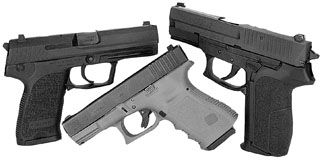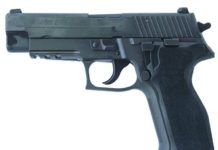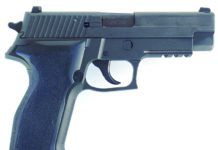
Most shooters don’t get too worked up about new polymer-framed auto pistols; they don’t have the charm of a well-built 1911 .45 ACP or the character of an old Chiefs Special .38. Instead, what plastic guns do well is protect their owners, and in this defensive role, they excel. If you doubt this statement, simply check out what gun is riding on the hip of today’s law-enforcement personnel. More often than not, it will be a polymer-framed high-cap 9mm or .40 S&W, and quite often, it will be a Glock.
Glock introduced the first successful plastic-framed pistol more than twenty years ago, and it is still the most popular polymer by a large margin. But several other manufacturers make comparable polymer pistols, and we recently tested two of such guns against the mainstay .40 S&W Glock Model 23.
Our first test product was the Heckler & Koch USP 40 Variant 9 .40 S&W USPLEM, $769. This design adds a manual thumb safety to the hinged-trigger USP pistol. Sigarms’s latest polymer pistol, the SP2022 .40 S&W (No. E2022-40-BSS, $715), offers a decocker. Our Glock 23 .40 S&W No. HXL616 cost $670. All three guns came with night sights, and barrel length was approximately 4 inches.
In these guns we shot Winchester’s 155-grain JHP Ranger loads, 180-grain hollowpoints from Black Hills Ammunition, and 165-grain FMJ rounds loaded to USPSA major caliber specifications by Georgia Arms (770-459-5117). This meant these rounds were expected to travel at an average velocity of at least 1000 fps from a 5-inch barrel.
For the testing, our shooters visited the comfortable confines of Top Gun of Texas (www.topgunrange.com), where we took advantage of the opportunity to adjust lighting conditions to test the effectiveness of each gun’s night sights. Using the Black Hills rounds exclusively in this portion of our tests, we fired standing unsupported from a distance of 7 yards. We adjusted backlighting to provide just enough illumination to allow us to see a 3-inch circle on a Hoffners ABC16 target (www.hoffners.com). We recorded the first 10-round group we shot. Accuracy data from the bench was recorded at 15 yards, and we fired single action only from the Sigarms and HK pistols.
Our first question was whether or not the Glock SafeAction trigger, a full-time double-action system, would put the Model 23 gun at a disadvantage. Second, we asked if the addition of an active safety on the Heckler & Koch pistol or, the decocker on the Sigarms SP2022, added safety, or did these mechanisms hinder operation. Though we formed definite likes and dislikes about each gun, we found that they all ran trouble free with a variety of ammunition. Otherwise, let’s get a detailed look at how well they shot in the text below:
The Heckler & Koch USP, or Universal Self-Loading Pistol, offers a distinctive, versatile design. There are actually 10 variations, beginning with Variant One, which places the thumb-operated safety in the familiar position of along the left side of frame. On the V1, and most of the USP variants, this lever also serves as a decocker, allowing the gun to be carried with hammer down for first-shot double action or hammer-back cocked and locked. In short, a traditional double-action pistol with a 1911 style safety.
Our USP 40 was a Variant 9. This meant that the one safety lever on the left side did not act as a decocker. (The Variant 10 has this lever on the right side of the frame.) The DA/SA trigger on our pistol was still in play, but returning to a safe hammer-down position meant gripping the hammer and gently letting it drop as the trigger was pressed. The hammer tang was sculpted with this task in mind, removing some of our fears. But we would nevertheless prefer to carry this gun either with hammer down over an empty chamber or cocked and locked, treating the gun like we would a 1911. Administrative handling of a cocked-and-locked pistol requires the index finger to be held straight and outside of the trigger guard with thumb always beneath the safety lever until ready to fire. If safety was an issue with this gun, then the heavy detent on the thumb safety of the USP 40 gave us added confidence. We wanted to know if the V9 was just the pistol for the 1911 shooter who wanted more capacity. In this case, 13+1 rounds of .40 S&W seemed to fulfill the need for more firepower.
If the presence of a thumb safety made the 1911 shooters feel at home, some shooters unfamiliar with using a manual safety may have to relearn their grip. But what about the rest of the gun?
The edges of the rear-sight unit were angled inward to provide a pyramid-like shape that starts with the profile of the slide. The purpose of this was to hasten visual index. This profile is popular with a number of competitive shooters, and we liked it. Removing the slide from the frame required the operator to shift the slide back to line up the relief and push the combination slide stop/slide release lever out from right to left. The top end, which was by far the heaviest part of the gun, consisted of barrel, slide and steel guide rod. There were two recoil springs, one of which was full length, that worked over the shorter one. Both springs were captured and stayed together as one unit with the guide rod. The frame was unusually light, even for polymer. The dustcover ran the full length of the slide and included an accessory rail, which was not a Weaver or Picatinny design.
The grip appeared paper thin at the sides but offered effective molded checkering front and rear and a pebble texture on the panels. HK relieved the lower edge of the grip panels to enhance access to the magazine if manual extraction should be required. A gloved finger would fit inside the oversized trigger guard. We could reach the magazine release from both sides and operate it with the strong-hand thumb and also the middle or index finger, a boon for left-handed shooters.
Once we had removed the gun’s slide, we noticed how sparse and simple the machinery was inside the frame. Without the decocking mechanism in place, the action appeared to be very simple. Moving parts included a transfer bar, hammer and sear plus a passive safety that locked out firing pin movement unless the trigger was pressed. Like the Glock pistol, the slide rode on a pair of steel inserts to the rear and another directly above the center of the trigger guard.
[PDFCAP(2)] we learned that the double action trigger didn’t present grit or creep, but it was too heavy, we thought. But V9 action lends itself to full-time single-action fire anyway. From the bench, the USP 40 edged out the Sigarms pistol with the 180-grain and 165-grain test loads. But the Sigarms SP2022 was fractionally better firing the aggressive Winchester Ranger ammunition that produced more than 500 foot-pounds of muzzle energy across the board. Standing and firing in dim light, we were able to rapid-fire ten shots into a 5.1-inch group at 7 yards.Our panel of shooters offered the following impressions about the gun’s handling. Firing the most powerful 155-grain rounds we felt the gun was more stable than the other pistols. At the bench we shot with a great deal of confidence and were surprised when our groups measured out to anything other than one ragged hole. But the USP 40 V9 did produce a best-of-test 1.5-inch average group firing the 165-grain ammunition.
[PDFCAP(3)]
The SP2022 pistol replaces the Model 2340 Sig Pro pistol, which we tested in our July 2005 issue. The SP2022 is the only polymer-framed pistol in the 2006 line of handguns from the Exeter, New Hampshire-based importer and manufacturer. Gone is the Sig Pro appellation, but the prefix “SP” was there to remind us of the family name.
New for 2006 was a Picatinny accessory rail on the underlug. The trigger was double/single-action. This model is not available with the full-time double-action DAK trigger or with the single-action-only triggers accompanied by a thumb safety found on the P220R SAO or P226 X-Five pistols. We’ve been told that the stateside plant has been expanded and complete guns are now being manufactured via CNC machines in New Hampshire. But the frame of our SP2022 read “Made in Germany.”
Besides its polymer frame, the SP2022 differs from Sig’s “P” series of handguns in a number of ways. The rear portion of the grip that covers the hammer spring consists of a removable sleeve. The gun came with two grip sleeves of different diameters and profiles. We needed a screwdriver to depress the spring-loaded insert that held the sleeves in place. But at least there were no small parts or roll pins to lose.
The magazine release was triangular instead of round, and we found it released mags smoothly. The decocker was also shaped differently, adding a shelf-like platform. A number of trainers advise manually switching to a ready position of hammer back single action first shot and using the decocker as a safety lever before holstering. We think the decocker on the SP2022 better accommodated this system than the decocker on the Sigarms P models. Removing the slide from the SP2022 was more difficult than on the P models, however.
Like on the HK pistol, the slide must be moved substantially to the rear and held manually instead of locked back by the slide-catch lever. We found pushing out the slide-catch lever from right to left to be difficult. It helped to use the corner of the magazine base to push it through the frame, but it still did not come out easily. With the top end removed, we saw that the locking insert was cavernous to accommodate the barrel locking lug that traps the crosspin of the slide-catch lever. The P series pistols unlock their barrels during cycling via a camming action. The result is the same, but the support surfaces are different.
One difference between the SP2022 and the HK USP 40 was that the frame rails were connected to modular units held inside the frame by pins. The HK slide ran on four separate contact points seated into the polymer. One other observation was that the trigger bar, which was exposed above the frame in the HK pistol was seated low and out of the way in the SP 2022.
At the range we really liked shooting this gun single action. This finding was consistent with previous tests of the SigPro model going back to an evaluation we published in August 1999. Another result consistent throughout our knowledge of this gun was its accuracy. All three of our guns offered consistent and pleasing accuracy from the bench, but the Sigarms SP2022 was the only one to land five-shot groups averaging less than 2 inches with each selection of ammunition. But we didn’t think this gun acquitted itself as well when fired double action. For us, there was too much difference between the long double-action pull and the fine single-action trigger. This made it difficult to coordinate a consistent string of fire that began with first-shot double action.
For our low-light rapid-fire test, we elected to thumb back the hammer and fire single action only. Firing in low light we could literally see the position of the sights each time the gun went off. We knew immediately when we scooped the trigger and dipped the muzzle that we had spoiled a fine group. The low imprint of this shot turned a 3.6-inch nine-shot group into a ten-shot group measuring 5.2 inches across. We liked the sights, the extra capacity, light weight and fine single-action trigger. The consensus was that with improved double action, or better yet a full-time single-action trigger, the SP2022 would be most desirable.
[PDFCAP(4)] The Model 23 is the midsized model in the Glock lineup. It follows the same design and configuration as all the other Glock pistols, the majority of which feed from a double-column magazine. The grip frame of the 23 was shorter than the full-size model 22. According to the website, (www.glock.com), 10-, 13-, and 15-round magazines are available. Our Model 23 arrived with three 13-round magazines and Trijicon night sights. The frame was colored O.D. green, and the underlug was molded to provide a Picatinny rail with one cross cut. The only external controls, save the combination trigger and passive safety, was the slide release and the magazine release, each on the left side only. The theme here was to produce a slick-bodied snagproof pistol. Even the latch to remove the slide was countersunk. The grip showed a mild palm swell to the rear and three finger grooves on the front. The trigger guard, which was squared and checkered at the front, was also undercut where it met the front strap. But we thought that the magazine release, which seemed to be abbreviated to avoid accidental operation, was spongy and too difficult to find.
To field strip the gun, we pushed the slide to the rear about one-quarter inch and pulled down simultaneously on the sliding locks found above the trigger guard on both sides of the frame. Moving the slide forward, it moved easily off of the frame. To reinstall it, we simply fitted the slide and frame together. The latches lock automatically. With the frame removed, we noticed that the barrel and slide were given additional support by a steel block placed directly behind the forward set of slide to frame contact points inlaid into the frame. This block also took part in unlocking the barrel during cycling. To our surprise this design more closely resembled the Sigarms P series than did our SP2022.
The Glock model 23 was the only pistol in the test that relied upon a striker for ignition. The Sigarm and HK pistols used a hammer to strike a firing pin. The Glock trigger is classified as full time double action because it draws back the striker and releases it when maximum energy has been stored in the spring. The result was a longer trigger process than the single action of either the HK or the Sigarms pistols. From the bench our Glock pistol finished third in accuracy. In sum, the Glock achieved the same level of accuracy with all three loads. In fact, all three guns achieved approximately the same level of accuracy with each of our test loads from support.
When we shot standing unsupported, it became evident that we needed to hold the Glock differently than the other pistols. The shooter’s wrist had to be canted forward so that the sights were level. Of course we also found that the Glock trigger required more movement. But it also felt the same from shot to shot, and this helped us produce the most consistent rapid fire hits. In our low-light test, we were able to produce the cleanest 10 shot group measuring 3.5 inches across.
Gun Tests Recommends
• Heckler & Koch USP 40 Variant 9 .40 S&W USPLEM, $769. Buy It. This may be the gun for the 1911 shooter who wants more capacity and less weight. Likewise, polymer-pistol fans who prefer an active safety may like it better than the Glock.
• Sigarms SP2022 .40 S&W No. E2022-40-BSS, $715. Don’t Buy. Put alongside the other guns, the SP2022’s double-action trigger was more difficult to operate, and that alone puts it third in this matchup. Should the SP2022 be offered with the new SAO single-action trigger, we might rate this gun much higher. But for now, there are many better alternatives.
• Glock 23 .40 S&W No. HXL616, $670. Our Pick. Some shooters would add an active safety, but the Glock pistol proved consistent and predictable, and it costs less. We also favored the green frame and night sights.




























